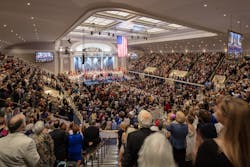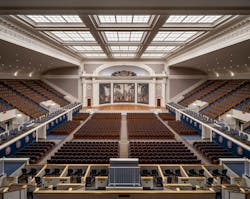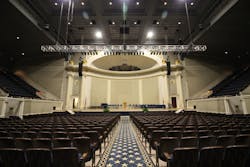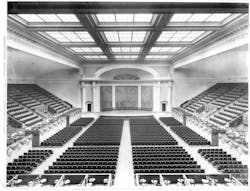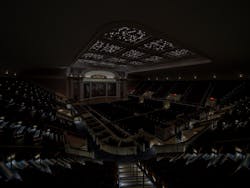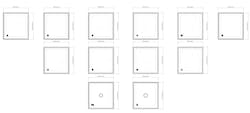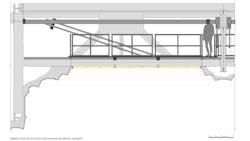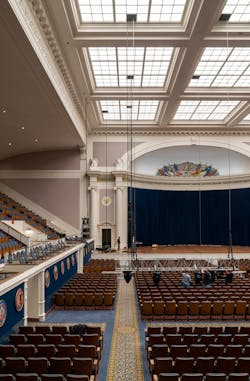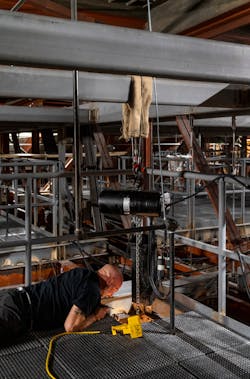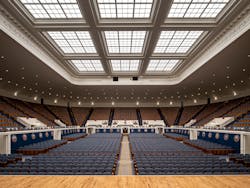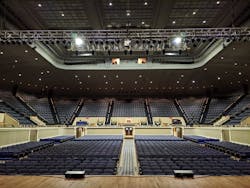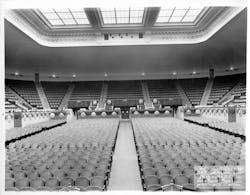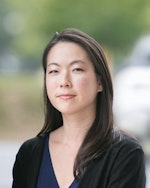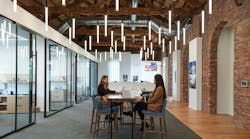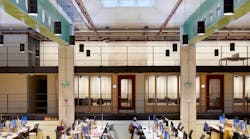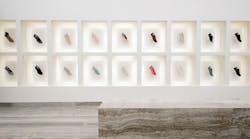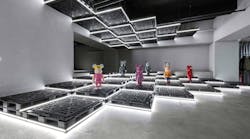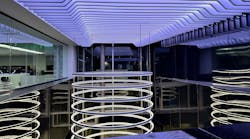Prior to the COVID pandemic, anyone gazing at the ceiling of the historic Constitution Hall at the National Society of the Daughters of the American Revolution (DAR) headquarters, in Washington, D.C., might believe the 12 grand coffers were always filled with solid panels. Instead, the grid of mullions and muntins dividing each coffer into 81 panes were the remnants of a majestic glass laylight over the 3,702-seat concert hall, completed in 1929 and designed by architect John Russell Pope. At day, natural light from a skylight above would filter through the laylight and fill the hall; at night, the stars would reveal themselves. This centerpiece would be closed off and roofed over in the 1950s.
As part of a multiyear, multiphase renovation of the DAR headquarters, local architecture firm Quinn Evans modernized Constitution Hall’s performance and support spaces to accommodate more event formats while preserving and restoring historic details, including the effect of the laylight. Project manager and Quinn Evans senior associate Katie Irwin says DAR members wanted “to restore Constitution Hall back to having its original appearance of daylight” and to experience gathering at their annual Continental Congress under the stars.
The challenge of achieving a daylight-filled environment with a decidedly closed-off ceiling would be softened only slightly by Quinn Evan’s prior experience of restoring an also impressive leaded glass laylight ceiling at DAR’s adjoining Memorial Continental Hall in an earlier phase. At Constitution Hall, however, the 2014 installation of a roof-mounted photovoltaic array atop its former skylight precluded the restoration of its original skylight and laylight. Instead the design team, which included the Chicago office of lighting design firm Schuler Shook and the local office of Loring Consulting Engineers, would have to re-create the effect.
Diffused daylight could be achieved through any number of available LED panel products; ensuring a uniform light distribution across the 24-inch-by-25.25-inch modules of the existing grid would be straightforward with today’s solid-state lighting technology. But creating a star-filled night sky—much less one that could twinkle—would require more thought. The team considered several options, such as the installation of video panels that would essentially turn the ceiling into an array of downward-facing display screens. But the idea “was discarded pretty quickly due to cost concerns,” said John Jacobsen, senior lighting designer at Schuler Shook.
An idea emerged that would leverage what was once a common complaint of older solid-state lighting products: the ability to see hot spots, or individual diodes, piercing through a diffuse layer. What if each illuminated star was an LED source exposed to view?
Jacobsen queried several manufacturers to gauge their interest in customizing a diffused light panel that combined point sources. In the end, Brescia, Italy–based Folio was “really excited about this,” says project architect and Quinn Evans associate Anne Kopf. Folio and the team worked through several mock-ups, experimenting with diode placement and integration with respect to the panel to ensure the pin light appeared sharp and visible without creating defects, such as a halo, in the surrounding diffuser.
Folio’s final iteration is a dual-mode product with tiny holes, ⅛ to ¼ inch in diameter, drilled into the acrylic diffuser of its edge-lit Opal 3L panels to expose the star spotlight—from its Pico line—installed just behind the panel surface. “The hole is just big enough [to reveal] the diode,” Jacobsen says. The LEDs are by Nichia and have a minimum color rendering index (CRI) of 90 and CRI R9 value of 50.
Kopf says the design team then had to fill the “whole ceiling plan with all the different star layouts and patterns … to make it [appear] as random and starlike as possible.” To achieve some economy of scale, the team limited the number of panel-and-starlight templates to 10, with each template containing between one and four stars, and strategically rotated installation orientations to create the scattering of 2,169 stars.
Of the 972 light panels, 60 have no stars to accommodate smoke detectors and sprinkler heads. These panels are also fixed in place, whereas the remaining panels can be removed by technical crews to facilitate the rigging of trusses, lighting, and equipment for the event below. “All the drivers are on board with the panel,” Jacobsen says. “It all comes out with just a pair of handles.”
To enable that portability, Folio also custom designed housing for each removable light panel that can “stand up to the rigors of being thrown around by the rigging staff,” Jacobsen adds. Panel connectors allow for easy plugging, unplugging, and bypassing so that the ceiling effectively becomes a grid of plug-and-play light modules. To access the panels, crew members walk on a newly added access floor through a maze of existing and new structural, HVAC, electrical, and utility infrastructure in an approximately 7-foot-tall attic space.
Both the panels and the point sources can smoothly dim to 1% or lower. “We worked with the manufacturer to dial in on the appropriate drive current that would give us good visibility, but maintain that dimming range,” Jacobsen says. The general lights and star points are DMX-dimmed using separate drivers, he adds, and “the driver for the star points is multichannel so that we can individually control the star points and get the twinkling effect through programming.”
An ETC Paradigm architectural processor controls day-to-day lighting scenarios through a touch screen station backstage and preset button stations at select room entrances. For events, crews can connect theatrical lighting consoles through an input panel in the backstage area. Jacobsen adds that the starlight twinkling effect can be called either through the architectural processor or through programming sequences in the theatrical lighting console. ETC’s Sensor IQ DMX-controlled relay panels allow staff to turn off power remotely to groups of fixtures during event setup or when the space is empty for long periods. The Sensor IQ relay panels can also ramp the laylights to 100% output in case of emergencies.
The timing of this renovation, from summer 2019 to the renewed Constitution Hall’s opening night in September 2021, meant that the project and construction team faced additional challenges related to the height of the COVID pandemic, including limited site visits, supply chain issues, and questionable quality control. But experiencing the grand venue restored to its light- and star-filled character is almost certain to put a twinkle in any visitor’s eye.
Project lighting credits
Primary lighting manufacturer: Folio
Lighting manufacturers: USAI (recessed downlights), Lucifer Lighting (vomitory steplights), Rejuvenation (sconces)
Lighting controls: Electronic Theatre Controls (manufacturer), Barbizon (dealer / integrator)
